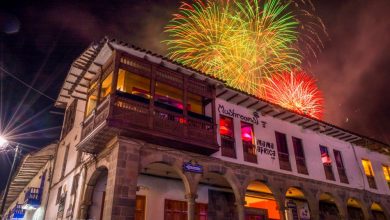Mythic Name in a New Clime, Ultima Hora in California

The Boulevard of the Dark Woman, La Morena, romantically traverses a part of San Diego, California. It claims the charm, beauty, and tempestuous fever of a Spanish gypsy while reminding me of older men, standing in line, and singing to the strum of a guitar a classic song of black, bandit eyes coming down from a wild and dark mountain. Both the mountain and the owner of the enchanting and unforgettable eyes were called La Morena.
Nonetheless, Morena Boulevard despite its grandiose name is unimpressive, although on it I found a little Latin market with a solid collection of Peruvian foods for sale — including the dark and rich chocolate tejas (filled tiles) — called Andrés.
To the side of the cash register, where a light colored woman with a tropical accent tried to convince me she was from the mountainous mining region of Durango, Mexico, I picked up a tabloid newspaper whose name reminded me of other places and other times.

In fact, it is an almost mythical name, that of a famed and now defunct Lima newspaper, Última Hora. It was the first, in 1950, to publish in the ordinary Spanish of Peru and not in a more formal code.
This popular style of speech and slang is called la replana and, though widely spread now throughout Peru, originated and maintains roots in Lima’s underworld, el hampa. This made Última Hora a paper that offered itself to ordinary Peruvians where they could read a language like that they heard around them and which they probably spoke.

It would be hard to overstate the power of this shift though now the language saturates much of Peruvian popular media.
After a history of growth and then expropriation at the hands of Peru’s military governments, return to its original owners, closure and restarting, the daily ceased publication in 1992.
To see the paper in San Diego was to be reminded of the power of the world of gypsies and other underclasses in Spain and Latin America, though amidst the glitz of a developed United States.
Founded in 1997, a brief five years after the definitive closure of the great Peruvian Ultima Hora, this paper which is published in the Los Angeles suburb of Norwalk, California oddly builds on the tradition of Última Hora while claiming a different public and a different language.

Its offering can be described as a trinity plus one: neoliberal economic development, tourism and Peruvian pride, and soccer (fútbol), plus advertising Peruvian businesses in Southern California, especially Los Angeles.
Gone is the effusive ordinary of la replana and in its place is business-speak, the language of an American-Peruvian middle and upper middle class.
The California paper is important in its more than seventeen years of continuity even if it only publishes monthly. It gives a presence to the Peruvian diaspora in California and builds a community through its stories and advertising. It may not be the Última Hora of el hampa in print, but it is the paper and dialect of a class of Peruvians who migrate, who thrive on the free trade agreement with the United States, and who carry their pride of nation on their sleeves even as their feet walk sidewalks in the behemoth of the north.




